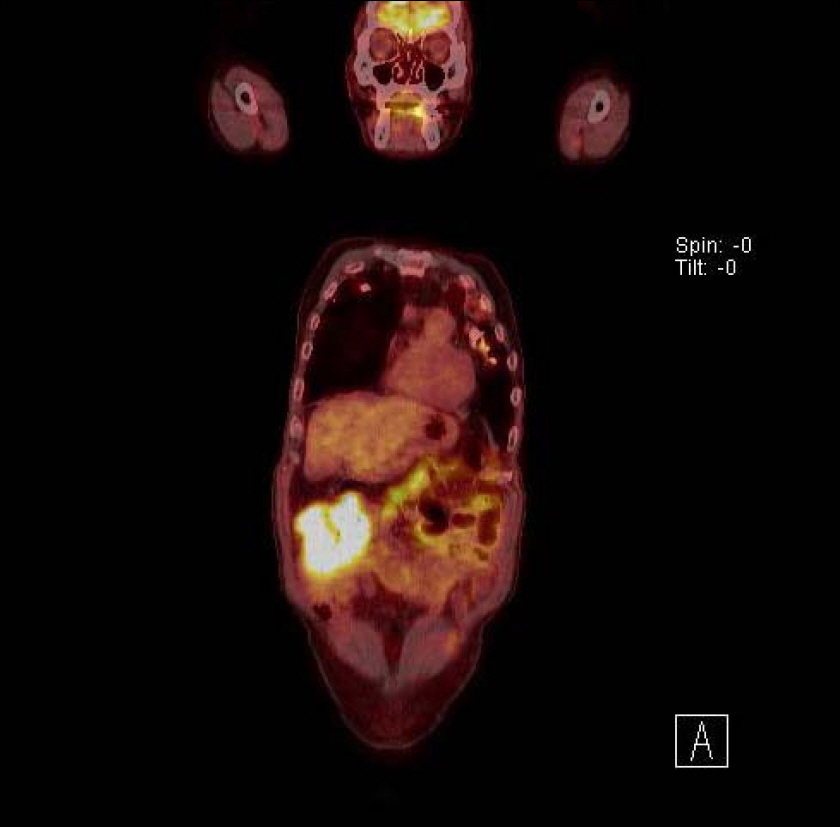Korean J Gastroenterol.
2014 Oct;64(4):229-233. 10.4166/kjg.2014.64.4.229.
A Case of Fungating Type Natural Killer Like T Cell Lymphoma of the Ascending Colon
- Affiliations
-
- 1Department of Internal Medicine and Research Institute for Convergence of Biomedical Science and Technology, Pusan National University Yangsan Hospital, Pusan National University School of Medicine, Yangsan, Korea. psubumi@naver.com
- 2Department of Pathology, Pusan National University Yangsan Hospital, Pusan National University School of Medicine, Yangsan, Korea.
- KMID: 1979208
- DOI: http://doi.org/10.4166/kjg.2014.64.4.229
Abstract
- Primary colorectal lymphoma is a very rare disease entity that accounts for less than 0.2-0.65% of all colon cancers. It is as an extranodal lymphoma of the colon that mainly arises from B cells and primary colorectal lymphoma that arises from T cells is very rare both in Western countries and in Korea. Colonic lymphoma can be classified endoscopically into 5 categories as follows: fungating, ulcerative, infiltrative, ulcerofungating, and ulceroinfiltrative type. The endoscopic features of primary colorectal lymphoma differ according to their cellular origin; about half of B cell lymphomas are fungating type whereas most of T cell lymphomas are of ulcerative or ulceroinfiltrative type. Mass forming primary T cell lymphoma of the colon is extremely rare. Herein, we present a case of primary natural killer like T cell lymphoma of the colon presenting as fungating type with review of literature.
MeSH Terms
Figure
Reference
-
References
1. Chan JK. Gastrointestinal lymphomas: an overview with emphasis on new findings and diagnostic problems. Semin Diagn Pathol. 1996; 13:260–296.2. Shepherd NA, Hall PA, Coates PJ, Levison DA. Primary malignant lymphoma of the colon and rectum. A histopathological and immunohistochemical analysis of 45 cases with clinicopathological correlations. Histopathology. 1988; 12:235–252.
Article3. Kim YH, Lee JH, Yang SK, et al. Primary colon lymphoma in Korea: a KASID (Korean Association for the Study of Intestinal Diseases) Study. Dig Dis Sci. 2005; 50:2243–2247.
Article4. Kim HS, Lee DK, Baik SK, Kwon SO, Cho MY, Ko YH. Primary CD56+ T/NK cell lymphoma of the colon. J Gastroenterol. 2002; 37:939–946.
Article5. Dawson IM, Cornes JS, Morson BC. Primary malignant lymphoid tumours of the intestinal tract. Report of 37 cases with a study of factors influencing prognosis. Br J Surg. 1961; 49:80–89.
Article6. Jaffe ES. The 2008 WHO classification of lymphomas: implications for clinical practice and translational research. Hematology Am Soc Hematol Educ Program;2009. p. 523–531.7. Harris NL, Jaffe ES, Diebold J, et al. The World Health Organization classification of neoplasms of the hematopoietic and lymphoid tissues: report of the Clinical Advisory Committee meeting–Airlie House, Virginia, November, 1997. Hematol J. 2000; 1:53–66.8. Sarris A, Ford R. Recent advances in the molecular pathogenesis of lymphomas. Curr Opin Oncol. 1999; 11:351–363.
Article9. Kwong YL. Natural killer-cell malignancies: diagnosis and treatment. Leukemia. 2005; 19:2186–2194.
Article10. Jaffe ES. Classification of natural killer (NK) cell and NK-like T-cell malignancies. Blood. 1996; 87:1207–1210.11. Tung CL, Hsieh PP, Chang JH, Chen RS, Chen YJ, Wang JS. Intestinal T-cell and natural killer-cell lymphomas in Taiwan with special emphasis on 2 distinct cellular types: natural killer-like cytotoxic T cell and true natural killer cell. Hum Pathol. 2008; 39:1018–1025.
Article12. Tse E, Gill H, Loong F, et al. Type II enteropathy-associated T-cell lymphoma: a multicenter analysis from the Asia Lymphoma Study Group. Am J Hematol. 2012; 87:663–668.
Article13. Ko YH, Cho EY, Kim JE, et al. NK and NK-like T-cell lymphoma in extranasal sites: a comparative clinicopathological study according to site and EBV status. Histopathology. 2004; 44:480–489.
Article14. Chim CS, Au WY, Shek TW, et al. Primary CD56 positive lymphomas of the gastrointestinal tract. Cancer. 2001; 91:525–533.
Article15. Zighelboim J, Larson MV. Primary colonic lymphoma. Clinical presentation, histopathologic features, and outcome with com-bination chemotherapy. J Clin Gastroenterol. 1994; 18:291–297.16. Lee YJ, Lee JH. Gastrointestinal lymphoma. Korean J Helicobacter Up Gastrointest Res. 2012; 12:158–165.
Article17. Zheng S, Ouyang Q, Li G, et al. Primary intestinal NK/T cell lymphoma: a clinicopathologic study of 25 Chinese cases. Arch Iran Med. 2012; 15:36–42.18. Chun HB, Baek IH, Lee MS, et al. Jejunocolic fistula associated with an intestinal T cell lymphoma. Gut Liver. 2011; 5:387–390.
Article19. Ryu SH, Cheon JH, Kim JY, et al. The early diagnostic accuracy for gastrointestinal T-cell lymphoma from a perspective of gas-troenterologist. Intest Res. 2011; 9:19–26.20. Lister TA, Crowther D, Sutcliffe SB, et al. Report of a committee convened to discuss the evaluation and staging of patients with Hodgkin's disease: Cotswolds meeting. J Clin Oncol. 1989; 7:1630–1636.
Article





